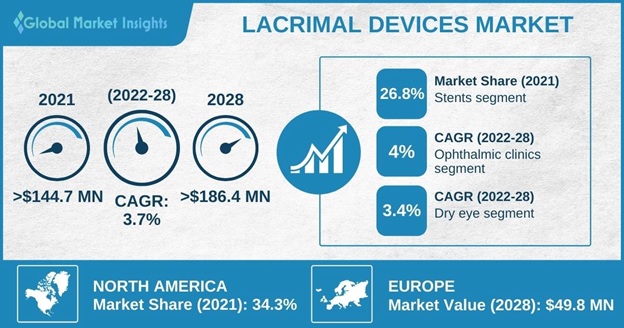Home > Healthcare > Medical Devices > Therapeutic Devices > Lacrimal Devices Market
Lacrimal Devices Market Size
- Report ID: GMI4811
- Published Date: Mar 2022
- Report Format: PDF
Lacrimal Devices Market Size
Lacrimal Devices Market size accounted for over USD 144.7 million in 2021 and is estimated to grow at 3.7% CAGR between 2022 and 2028. Rising prevalence of eye disease is expected to boost the adoption of lacrimal devices in the projected timeframe. Dacryocystitis is an infection of the lacrimal sacs or tear sacs that causes redness, pain, and discomfort in the lower corner of eye. According to the Review of Ophthalmology, development of congenital dacryocele to an acute dacryocystitis may occur in 20 to 72.5% of patients. This has led to an increase in the demand for lacrimal devices.
Lacrimal devices are ophthalmic protective system that helps to keep eyes moist and free from dust particles. These lacrimal devices are usually constrained to lacrimal ducts and nasal punctum of the eye. Certain factors that are driving the market growth include rising demand for minimally invasive treatment and increasing patient pool of nasolacrimal duct obstruction
| Report Attribute | Details |
|---|---|
| Base Year: | 2021 |
| Lacrimal Devices Market Size in 2021: | 144.8 Million (USD) |
| Forecast Period: | 2022 to 2028 |
| Forecast Period 2022 to 2028 CAGR: | 3.7% |
| 2028 Value Projection: | 186.5 Million (USD) |
| Historical Data for: | 2017 to 2021 |
| No. of Pages: | 145 |
| Tables, Charts & Figures: | 215 |
| Segments covered: | Product, Application, End-use and Region |
| Growth Drivers: |
|
| Pitfalls & Challenges: |
|
The emergency of COVID-19 pandemic has disrupted every aspect of ophthalmology service and ophthalmic practice. Various companies witnessed a slowdown in product volumes in 2020 as well as faced significant challenges in exporting the products. This can be attributed to increasing number of COVID-19 infections along with restrictions, delaying or postponing of the non-essential surgical and non-invasive procedures. For instance, the American College of Surgeons provided guidelines to postpone non-emergency surgical procedures including cataract surgery, endoscopic dacryocystorhinostomy and lacrimal surgeries. This has potentially decreased the procedure volume, indicating that the COVID-19 pandemic had a negative impact on the lacrimal device market expansion.

